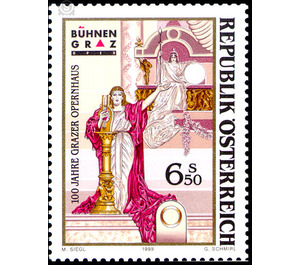100 years - Austria / II. Republic of Austria 1999 - 6.50 Shilling
Theme: Art & Culture
| Country | Austria / II. Republic of Austria |
| Issue Date | 1999 |
| Face Value | 6.50 |
| Printing Type | combination printing |
| Stamp Type | Commemorative |
| Item Type | Stamp |
| Chronological Issue Number | 1637 |
| Chronological Chapter | OOS-OE2 |
| SID | 601456 |
| In 63 Wishlists | |
The interior of the Graz Opera House is rightly regarded as one of the most beautiful interior ensembles that opera houses worldwide have to offer, and as the most stylistically successful work by the architectural duo Helmer and Fellner. The neo-baroque Prunck building was modeled on the express wish of the builders, the Graz municipal council, the style of the Austrian Baroque architect Fischer von Erlach. Inside, this style has remained unchanged since the opening of the house on 16 September 1899. However, the exterior of the building has changed significantly after the relatively light bomb damage suffered by the house in 1944. In the years 1983/84, the opera house underwent a much-needed renovation and at the same time created the technical conditions for modern and rational processes. The Graz Opera House was opened as the "Graz City Theater". The composer Richard Wagner and the poet Friedrich Schiller are considered artistic leading figures of the new building. This is also reflected in the design of the central ceiling paintings in the auditorium: Richard Wagner's "Lohengrin" is flanked by Schiller's "Wilhelm Tell" and Goethe's "Faust". The motif for the 100th anniversary stamp is the "Goddess of Light with the Immaculate Shield of Purity and the Eternally Shining Torch".


